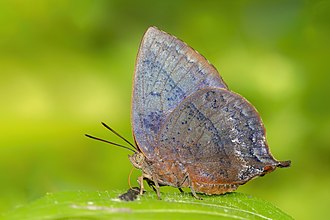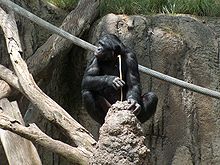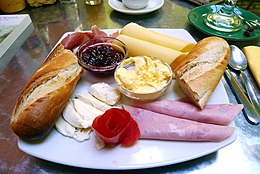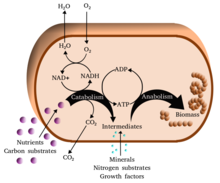The Term Fresco Refers To

Nutrition is the biochemical and physiological procedure by which an organism uses nutrient to support its life. It provides organisms with nutrients, which can be metabolized to create free energy and chemical structures. Failure to obtain sufficient nutrients causes malnutrition. Nutritional scientific discipline is the study of nutrition, though it typically emphasizes human nutrition.
The type of organism determines what nutrients it needs and how it obtains them. Organisms obtain nutrients by consuming organic matter, consuming inorganic matter, arresting light, or some combination of these. Some tin can produce nutrients internally by consuming basic elements, while some must consume other organisms to obtain preexisting nutrients. All forms of life require carbon, energy, and h2o besides every bit various other molecules. Animals require complex nutrients such as carbohydrates, lipids, and proteins, obtaining them by consuming other organisms. Humans have developed agriculture and cooking to supplant foraging and advance human nutrition. Plants acquire nutrients through soil and the atmosphere. Fungi absorb nutrients around them by breaking them down and arresting them through the mycelium.
Study [edit]
Scientific assay of food and nutrients began during the chemic revolution in the late-18th century. Chemists in the 18th and 19th centuries experimented with different elements and food sources to develop theories of nutrition.[ane] Modern nutrition science began in the 1910s equally individual micronutrients began to be identified. The kickoff vitamin to be chemically identified was thiamine in 1926, and the part of vitamins in nutrition was studied in the following decades. The get-go recommended dietary allowances for humans were adult during the Dandy Depression and Earth War Ii.[2] Due to its importance in human health, the study of nutrition has heavily emphasized human nutrition and agriculture, while ecology is a secondary concern.[3]
Nutrients [edit]
Nutrients are substances that provide free energy and physical components to the organism, allowing it to survive, grow, and reproduce. Nutrients tin be basic elements or circuitous macromolecules. Approximately 30 elements are found in organic matter, with nitrogen, carbon, and phosphorus being the most important.[4] Macronutrients are the primary substances required by an organism, and micronutrients are substances required by an organism in trace amounts. Organic micronutrients are classified as vitamins, and inorganic micronutrients are classified as minerals.[5]
Nutrients are absorbed past the cells and used in metabolic biochemical reactions. These include fueling reactions that create precursor metabolites and free energy, biosynthetic reactions that convert forerunner metabolites into edifice cake molecules, polymerizations that combine these molecules into macromolecule polymers, and assembly reactions that use these polymers to construct cellular structures.[four]
Nutritional groups [edit]
Organisms tin can be classified by how they obtain carbon and free energy. Heterotrophs are organisms that obtain nutrients past consuming the carbon of other organisms, while autotrophs are organisms that produce their own nutrients from the carbon of inorganic substances like carbon dioxide. Mixotrophs are organisms that tin can be heterotrophs and autotrophs, including some plankton and cannibal plants. Phototrophs obtain energy from light, while chemotrophs obtain energy by consuming chemic free energy from matter. Organotrophs eat other organisms to obtain electrons, while lithotrophs obtain electrons from inorganic substances, such as h2o, hydrogen sulfide, dihydrogen, iron(II), sulfur, or ammonium.[6] Prototrophs can create essential nutrients from other compounds, while auxotrophs must eat preexisting nutrients.[7]
Diet [edit]
| | This department needs expansion. Y'all can help past adding to it. (August 2022) |
In nutrition, the diet of an organism is the sum of foods it eats.[eight]
Nutrient bike [edit]
A food cycle is a biogeochemical wheel involving the movement of inorganic matter through a combination of soil, organisms, air or h2o, where they are exchanged in organic thing.[ix] Energy flow is a unidirectional and noncyclic pathway, whereas the movement of mineral nutrients is cyclic. Mineral cycles include the carbon wheel, sulfur cycle, nitrogen cycle, water cycle, phosphorus wheel, oxygen cycle, among others that continually recycle forth with other mineral nutrients into productive ecological nutrition.[ix]
Foraging [edit]

Foraging is the process of seeking out nutrients in the environment. It may also exist divers to include the subsequent apply of the resource. Some organisms, such equally animals and bacteria, tin can navigate to find nutrients, while others, such as plants and fungi, extend outward to observe nutrients. Foraging may be random, in which the organism seeks nutrients without method, or it may be systematic, in which the organism can go directly to a food source.[10] Organisms are able to detect nutrients through taste or other forms of nutrient sensing, allowing them to regulate nutrient intake.[11] Optimal foraging theory is a model that explains foraging beliefs as a cost–benefit assay in which an animate being must maximize the gain of nutrients while minimizing the corporeality of time and energy spent foraging. It was created to analyze the foraging habits of animals, but it can also be extended to other organisms.[12] Some organisms are specialists that are adjusted to forage for a single food source, while others are generalists that can consume a variety of food sources.[13]
Nutrient deficiency [edit]
Nutrient deficiencies, known as malnutrition, occur when an organism does non have the nutrients that it needs. This may be acquired by arresting insufficient nutrients or by all of a sudden losing nutrients. When this occurs, an organism volition suit by reducing free energy consumption and expenditure to prolong the use of stored nutrients. It will use stored energy reserves until they are depleted, and information technology will then break down its own body mass for boosted free energy.[14]
In organisms [edit]
Fauna [edit]

Animals are heterotrophs that consume other organisms to obtain nutrients. Herbivores are animals that eat plants, carnivores are animals that consume other animals, and omnivores are animals that swallow both plants and other animals.[15] Many herbivores rely on bacterial fermentation to create digestible nutrients from indigestible plant cellulose, while obligate carnivores must eat fauna meats to obtain certain vitamins or nutrients their bodies cannot otherwise synthesize. Animals generally have a higher requirement of energy in comparison to plants.[xvi] The macronutrients essential to brute life are carbohydrates, amino acids, and fatty acids.[5]
Carbohydrates are molecules that shop significant amounts of energy. Animals assimilate and metabolize carbohydrates to obtain this free energy. Carbohydrates are typically synthesized by plants during metabolism, and animals have to obtain nigh carbohydrates from nature, every bit they have only a limited ability to generate them. They include sugars, oligosaccharides, and polysaccharides. Glucose is the simplest form of saccharide.[17] Carbohydrates are broken down to produce glucose and curt-concatenation fat acids, and they are the most arable nutrients for herbivorous land animals.[xviii]
Lipids provide animals with fats and oils. They are not soluble in water, and they can store free energy for an extended period of time. They tin be obtained from many unlike plant and animal sources. Most dietary lipids are triglycerides, composed of glycerol and fatty acids. Phospholipids and sterols are establish in smaller amounts.[xix] An animal's body will reduce the amount of fatty acids it produces as dietary fatty intake increases, while it increases the corporeality of fatty acids information technology produces as carbohydrate intake increases.[20]
Protein consumed by animals is cleaved downwardly to amino acids, which would be later on used to synthesize new proteins. Protein is used to form cellular structures, fluids,[21] and enzymes (biological catalysts). Enzymes are essential to most metabolic processes, as well as DNA replication, repair, and transcription.[22]
Much of beast beliefs is governed past nutrition. Migration patterns and seasonal breeding take place in conjunction with food availability, and courtship displays are used to brandish an animal's wellness.[23] Animals develop positive and negative associations with foods that bear upon their health, and they tin can instinctively avoid foods that have caused toxic injury or nutritional imbalances through a conditioned nutrient aversion. Some animals, such equally rats, practise not seek out new types of foods unless they have a food deficiency.[24]
Human [edit]

Early human nutrition consisted of foraging for nutrients similar to that of other animals, simply it diverged at the beginning of the Holocene with the Neolithic Revolution, in which humans adult agriculture to produce food. The Chemical Revolution in the 18th century allowed humans to study the nutrients in foods and develop more avant-garde methods of nutrient training. Major advances in economics and engineering during the 20th century allowed mass production and food fortification to better run across the nutritional needs of humans.[25] Homo beliefs is closely related to human being nutrition, making information technology a subject of social science in addition to biological science. Nutrition in humans is counterbalanced with eating for pleasure, and optimal diet may vary depending on the demographics and health concerns of each person.[26]
Humans are omnivores that eat a diversity of foods. Cultivation of cereals and product of bread has fabricated upward a primal component of human nutrition since the starting time of agriculture. Early on humans hunted animals for meat, and modern humans domesticate animals to swallow their meat and eggs. The evolution of animal husbandry has too immune humans in some cultures to consume the milk of other animals and produce information technology into foods such as cheese. Other foods eaten by humans include nuts, seeds, fruits, and vegetables. Access to domesticated animals as well as vegetable oils has caused a pregnant increment in human being intake of fats and oils. Humans accept developed advanced methods of food processing that prevents contamination of pathogenic microorganisms and simplify the production of food. These include drying, freezing, heating, milling, pressing, packaging, refrigeration, and irradiation. Virtually cultures add herbs and spices to foods before eating to add together flavor, though most exercise not significantly affect nutrition. Other additives are too used to meliorate the safety, quality, flavor, and nutritional content of nutrient.[27]
Humans obtain nigh carbohydrates equally starch from cereals, though carbohydrate has grown in importance.[17] Lipids can be found in animal fatty, butterfat, vegetable oil, and leafage vegetables, and they are likewise used to increase flavor in foods.[19] Poly peptide can be found in virtually all foods, as information technology makes up cellular fabric, though certain methods of food processing may reduce the corporeality of protein in a food.[28] Humans can also obtain free energy from ethanol, which is both a nutrient and a drug, but information technology provides relatively few essential nutrients and is associated with nutritional deficiencies and other health risks.[29]
In humans, poor nutrition tin can cause deficiency-related diseases such as blindness, anemia, scurvy, preterm nativity, stillbirth and cretinism,[xxx] or nutrient excess health-threatening conditions such as obesity[31] [32] and metabolic syndrome;[33] and such common chronic systemic diseases equally cardiovascular disease,[34] diabetes,[35] [36] and osteoporosis.[37] Undernutrition can lead to wasting in acute cases, and stunting of marasmus in chronic cases of malnutrition.[30]
Domesticated animal [edit]
In domesticated animals, such as pets, livestock, and working animals, likewise as other animals in captivity, nutrition is managed by humans through animal feed. Fodder and forage are provided to livestock. Specialized pet food has been manufactured since 1860, and subsequent research and evolution take addressed the nutritional needs of pets. Dog nutrient and cat nutrient in item are heavily studied and typically include all essential nutrients for these animals. Cats are sensitive to some mutual nutrients, such equally taurine, and require additional nutrients derived from meat. Large-breed puppies are susceptible to overnutrition, every bit small-scale-breed dog food is more energy dense than they can blot.[38]
Plant [edit]

Schematic of photosynthesis in plants. The carbohydrates produced are stored in or used past the plant.
Most plants obtain nutrients through inorganic substances captivated from the soil or the temper. Carbon, hydrogen, oxygen, nitrogen, and sulfur are essential nutrients that brand upwardly organic textile in a plant and allow enzymic processes. These are absorbed ions in the soil, such equally bicarbonate, nitrate, ammonium, and sulfate, or they are absorbed as gases, such as carbon dioxide, water, oxygen gas, and sulfur dioxide. Phosphorus, boron, and silicon are used for esterification. They are obtained through the soil as phosphates, boric acid, and silicic acid, respectively. Other nutrients used by plants are potassium, sodium, calcium, magnesium, manganese, chlorine, atomic number 26, copper, zinc, and molybdenum.[39]
Plants uptake essential elements from the soil through their roots and from the air (consisting of mainly nitrogen and oxygen) through their leaves. Food uptake in the soil is achieved by cation substitution, wherein root hairs pump hydrogen ions (H+) into the soil through proton pumps. These hydrogen ions readapt cations attached to negatively charged soil particles then that the cations are available for uptake past the root. In the leaves, stomata open up to have in carbon dioxide and expel oxygen.[40] Although nitrogen is plentiful in the World's temper, very few plants can use this direct. Most plants, therefore, require nitrogen compounds to be present in the soil in which they grow. This is made possible by the fact that largely inert atmospheric nitrogen is changed in a nitrogen fixation process to biologically usable forms in the soil past bacteria.[41]
As these nutrients do not provide the plant with energy, they must obtain energy by other means. Green plants absorb energy from sunlight with chloroplasts and convert it to usable energy through photosynthesis.[42]
Fungus [edit]
Fungi are chemoheterotrophs that consume external thing for free energy. Most fungi absorb matter through the root-similar mycelium, which grows through the organism's source of nutrients and can extend indefinitely. The fungus excretes extracellular enzymes to break down surrounding matter and and so absorbs the nutrients through the prison cell wall. Fungi can be parasitic, saprophytic, or symbiotic. Parasitic fungi adhere and feed on living hosts, such as animals, plants, or other fungi. Saprophytic fungi feed on dead and decomposing organisms. Symbiotic fungi grow effectually other organisms and exchange nutrients with them.[43]
Protist [edit]
Protists include all eukaryotes that are non animals, plants, or fungi, resulting in great variety between them. Algae are photosynthetic protists that can produce free energy from low-cal. Several types of protists use mycelium similar to those of fungi. Protozoa are heterotrophic protists, and different protozoa seek nutrients in unlike ways. Flagellate protozoa apply a flagellum to aid in hunting for food, and some protozoa travel via infectious spores to act as parasites.[44] Many protists are mixotrophic, having both phototrophic and heterotrophic characteristics. Mixotrophic protists will typically depend on one source of nutrients while using the other every bit a supplemental source or a temporary alternative when its principal source is unavailable.[45]
Prokaryote [edit]

Prokaryotes, including bacteria and archaea, vary greatly in how they obtain nutrients across nutritional groups. Prokaryotes can only transport soluble compounds beyond their cell envelopes, just they can interruption down chemical components effectually them. Some lithotrophic prokaryotes are extremophiles that can survive in nutrient-deprived environments past breaking down inorganic matter.[46] Phototrophic prokaryotes, such equally blue-green alga and Chloroflexia, can engage in photosynthesis to obtain energy from sunlight. This is common among bacteria that grade in mats atop geothermal springs. Phototrophic prokaryotes typically obtain carbon from assimilating carbon dioxide through the Calvin bicycle.[47]
Some prokaryotes, such as Bdellovibrio and Ensifer, are predatory and feed on other unmarried-celled organisms. Predatory prokaryotes seek out other organisms through chemotaxis or random standoff, merge with the organism, degrade information technology, and absorb the released nutrients. Predatory strategies of prokaryotes include attaching to the outer surface of the organism and degrading it externally, entering the cytoplasm of the organism, or by inbound the periplasmic infinite of the organism. Groups of predatory prokaryotes may forgo zipper by collectively producing hydrolytic enzymes.[48]
Meet also [edit]
- Liebig's police force of the minimum
- Nutrient density
- Nutrition analysis
- Resources (biology)
- Substrate (biology)
References [edit]
- ^ Carpenter, Kenneth J. (1 March 2003). "A Short History of Nutritional Science: Part 1 (1785–1885)". The Periodical of Nutrition. 133 (three): 638–645. doi:10.1093/jn/133.3.638. ISSN 0022-3166. PMID 12612130. Archived from the original on vi August 2022. Retrieved vi August 2022.
- ^ Mozaffarian, Dariush; Rosenberg, Irwin; Uauy, Ricardo (13 June 2018). "History of modern nutrition science—implications for electric current research, dietary guidelines, and food policy". BMJ. 361: k2392. doi:10.1136/bmj.k2392. ISSN 0959-8138. PMC5998735. PMID 29899124. Archived from the original on 6 August 2022. Retrieved vi August 2022.
- ^ Simpson & Raubenheimer 2012, p. 2.
- ^ a b Andrews 2017, pp. lxx–72.
- ^ a b Wu 2017, pp. ii–4.
- ^ Andrews 2017, pp. 72–79.
- ^ Andrews 2017, p. 93.
- ^ "Diet". National Geographic . Retrieved 8 August 2022.
- ^ a b Allaby, Michael (2015). "Nutrient cycle". A Dictionary of Ecology (5th ed.). Oxford: Oxford University Press. ISBN978-0-19-179315-8. (subscription required)
- ^ Andrews 2017, pp. 83–85.
- ^ Simpson & Raubenheimer 2012, p. 36.
- ^ Andrews 2017, p. 16.
- ^ Andrews 2017, p. 98.
- ^ Mora, Rafael J.F. (1 June 1999). "Malnutrition: Organic and Functional Consequences". Earth Journal of Surgery. 23 (vi): 530–535. doi:10.1007/PL00012343. ISSN 1432-2323. PMID 10227920. S2CID 21037746. Archived from the original on 8 August 2022. Retrieved 7 August 2022.
- ^ Wu 2017, p. i.
- ^ National Geographic Society (21 January 2011). "Herbivore". National Geographic Society. Archived from the original on 25 Feb 2017. Retrieved 1 May 2017.
- ^ a b Mann & Truswell 2012, pp. 21–26.
- ^ Wu 2017, pp. 193–194.
- ^ a b Mann & Truswell 2012, pp. 49–55.
- ^ Wu 2017, p. 271.
- ^ Mann & Truswell 2012, pp. 70–73.
- ^ Bairoch A (January 2000). "The ENZYME database in 2000" (PDF). Nucleic Acids Inquiry. 28 (1): 304–05. doi:10.1093/nar/28.1.304. PMC102465. PMID 10592255. Archived from the original (PDF) on 1 June 2011.
- ^ Simpson & Raubenheimer 2012, pp. 3–four.
- ^ Simpson & Raubenheimer 2012, pp. 39–41.
- ^ Trüeb, Ralph M. (2020). "Brief History of Human Nutrition". Diet for Salubrious Hair. Springer. pp. 3–xv. doi:10.1007/978-three-030-59920-1_2. ISBN978-3-030-59920-1. S2CID 229617949.
- ^ Mann & Truswell 2012, p. 1.
- ^ Mann & Truswell 2012, pp. 409–437.
- ^ Isle of man & Truswell 2012, p. 86.
- ^ Mann & Truswell 2012, pp. 109–120.
- ^ a b Whitney, Ellie; Rolfes, Sharon Rady (2013). Understanding Nutrition (thirteen ed.). Wadsworth, Cengage Learning. pp. 667, 670. ISBN978-1-133-58752-1.
- ^ Wright, Margaret E.; Chang, Shih-Chen; Schatzkin, Arthur; Albanes, Demetrius; Kipnis, Victor; Mouw, Traci; Hurwitz, Paul; Hollenbeck, Albert; Leitzmann, Michael F. (15 February 2007). "Prospective study of adiposity and weight change in relation to prostate cancer incidence and mortality". Cancer. 109 (4): 675–684. doi:10.1002/cncr.22443. PMID 17211863. S2CID 42010929.
- ^ "Defining Adult Overweight and Obesity". Centers for Illness Command and Prevention. seven June 2021. Archived from the original on 28 September 2021. Retrieved 22 September 2021.
- ^ "Metabolic syndrome – PubMed Health". Ncbi.nlm.nih.gov. National Middle for Biotechnology Information. Archived from the original on 5 February 2011. Retrieved 17 October 2011.
- ^ "Omega-iii fatty acids". Umm.edu. 5 October 2011. Archived from the original on 9 July 2008. Retrieved 17 Oct 2011.
- ^ What I need to know near eating and diabetes (PDF). U.Southward. Section of Health and Human Services, National Institutes of Health, National Institute of Diabetes and Digestive and Kidney Diseases, National Diabetes Information Clearinghouse. 2007. OCLC 656826809. Archived (PDF) from the original on eight August 2022. Retrieved 22 September 2021.
- ^ "Diabetes Diet and Food Tips: Eating to Foreclose and Command Diabetes". Helpguide.org. Archived from the original on 20 May 2011. Retrieved 17 October 2011.
- ^ "Dietary Supplement Fact Sheet: Vitamin D". Role of Dietary Supplements, US National Institutes of Health. Archived from the original on 6 July 2011. Retrieved 17 August 2021.
- ^ Taylor, Marking B. (2011). "Pet Diet". In Davis, Radford Chiliad. (ed.). Caring for Family Pets: Choosing and Keeping Our Companion Animals Healthy. ABC-CLIO. pp. 177–194. ISBN978-0-313-38527-8.
- ^ Mengel et al. 2001, pp. 1–3.
- ^ Mengel et al. 2001, pp. 111–135.
- ^ Lindemann, Due west.C.; Glover, C.R. (2003). "Nitrogen Fixation by Legumes". New United mexican states State University. Archived from the original on 17 May 2013.
- ^ Mengel et al. 2001, pp. 136–137.
- ^ Charya, M. A. Singara (2015). "Fungi: An Overview". In Bahadur, Bir; Rajam, Manchikatla Venkat; Sahijram, Leela; Krishnamurthy, One thousand. V. (eds.). Plant Biological science and Biotechnology. Springer. pp. 197–215. doi:10.1007/978-81-322-2286-6_7. ISBN978-81-322-2286-half dozen.
- ^ Archibald, John Chiliad.; Simpson, Alastair G. B.; Slamovits, Claudio H., eds. (2017). Handbook of the Protists (2d ed.). Springer. pp. 2–iv. doi:10.1007/978-3-319-28149-0. ISBN978-3-319-28149-0. LCCN 2017945328. S2CID 43539893.
- ^ Jones, Harriet (1997). "A classification of mixotrophic protists based on their behaviour". Freshwater Biology. 37 (ane): 35–43. doi:10.1046/j.1365-2427.1997.00138.x. ISSN 0046-5070. Archived from the original on 21 Feb 2022. Retrieved 8 August 2022.
- ^ Southam, Yard.; Westall, F. (2007). "Geology, Life and Habitability". In Schubert, Gerald (ed.). Treatise on Geophysics (PDF). Vol. 10: Planets and Moons. Elsevier. pp. 421–437. doi:ten.1016/B978-044452748-6.00164-iv. ISBN9780444527486.
- ^ Overmann, Jörg; Garcia-Pichel, Ferran (2006). "The Phototrophic Manner of Life". In Dworkin, Martin (ed.). The Prokaryotes. Vol. two: Ecophysiology and Biochemistry (3rd ed.). Springer. pp. 203–257. doi:10.1007/0-387-30742-7_3. ISBN978-0-387-25492-0.
- ^ Martin, Mark O. (2002). "Predatory prokaryotes: an emerging research opportunity". Journal of Molecular Microbiology and Biotechnology. 4 (five): 467–477. ISSN 1464-1801. PMID 12432957. Archived from the original on 3 August 2022. Retrieved 6 Baronial 2022.
Bibliography [edit]
- Andrews, John H. (2017). Comparative Ecology of Microorganisms and Macroorganisms (2d ed.). New York: Springer. ISBN978-ane-4939-6897-8.
- Mann, Jim; Truswell, A. Stewart, eds. (2012). Essentials of Human Diet (4th ed.). Oxford: Oxford University Press. ISBN978-0-19-956634-1.
- Mengel, Konrad; Kirkby, Ernest A.; Kosegarten, Harald; Appel, Thomas, eds. (2001). Principles of Constitute Nutrition (5th ed.). New York: Springer. doi:10.1007/978-94-010-1009-two. ISBN978-94-010-1009-two. S2CID 9332099.
- Simpson, Stephen J.; Raubenheimer, David (2012). The Nature of Nutrition: A Unifying Framework from Animal Adaptation to Homo Obesity. Princeton: Princeton Academy Press. ISBN978-1-4008-4280-3.
- Wu, Guoyao (2017). Principles of Animal Nutrition. Boca Raton: CRC Press. ISBN978-1-351-64637-half dozen.
External links [edit]
![]()
Await upward diet in Wiktionary, the free lexicon.
![]()
Wikimedia Eatables has media related to Diet.
The Term Fresco Refers To,
Source: https://en.wikipedia.org/wiki/Nutrition
Posted by: hansonlins1970.blogspot.com


0 Response to "The Term Fresco Refers To"
Post a Comment